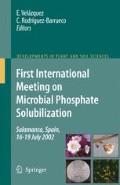Abstract
Savannas are natural ecosystems that predominate in the tropics. These systems usually have acid soils with low fertility in which nutrients, specially phosphorus, are scarce. Phosphorus is generally fixed in insoluble forms that cannot be rapidly incorporated by plants. In acid soils phosphorus is fixed as aluminum and iron phosphates; in calcareous soils phosphorus is fixed as calcium phosphate. In both cases these phosphorus forms need to be solubilized in order to make phosphate ions available to the plant in soil solution. Besides the natural soil acidity, organic acids produced through microbial mechanisms or plant roots have been proved to solubilize these phosphates. I investigated if native plant rhizospheres of acid or calcareous soils are enriched with phosphate solubilizing microorganisms, in order to find mechanisms to improve plant nutrition and agrosystem sustainability. The rhizosphere of a typical and dominant grass from savannas, Trachypogon plumosus Ness, was studied in order to corroborate the former hypothesis. Furthermore different phosphorus forms in rhizospheric soil were determined applying Hedley et al., (1982) P-fractionation method. T. plumosus growing in acid and neutral-calcareous soil rhizospheres were compared in terms of microbial populations and phosphate fractions. My results show that in many of the rhizospheres considered P-Al and P-Fe solubilizing organisms predominate when P-Al and P-Fe are important P fractions present in soil. This was not the case in calcareous soils where P-Ca solubilizing organisms P-Ca fractions predominate in soil. Through this approach I elucidate mechanisms operating in plant rhizospheres to make hardly soluble phosphates available to plants. The implications of such mechanisms on biotechnological and agricultural approaches are discussed.
Access this chapter
Tax calculation will be finalised at checkout
Purchases are for personal use only
Preview
Unable to display preview. Download preview PDF.
References
Barea J M, Azcón R and Hayman D 1975 Possible synergistic interactions between Endogone and phosphate-solubilizing bacteria in low-phosphate soils. In Endomycorrhizas. Eds. F E Sanders, B Mosse and P B Tinker. pp. 409–417. Academic Press, London.
Hedley M J, Stewart J W B and Chauhan B S 1982 Changes in inorganic and organic soil phosphorus fractions induced by cultivation practices and by laboratory incubations. Soil Sci. Soc. Am. J. 46, 970–976.
Hernández-Valencia I and López-Hernandez D 1999 Allocation of phosphorous in a tropical savanna. Chemosphere 39, 199–207.
Illmer P 1995 Solubilization of hardly soluble AlP04 with P-solubilizing microorganisms. Soil Biol. Biochem. 27, 265–270.
Kucey R M N, Janzen H H and Leggett M E 1989 Microbially mediated increases in plant-available phosphorus. Adv. Agron. 42, 199–228.
Linderman R 1988 Mycorrhizal interaction with the rhizosphere microflora: The mycorrhizosphere effect. Phytopathology 78, 488–505.
López-Hernández D 1977 La química del fósforo en suelos ácidos. Ediciones de la Biblioteca, Caracas.
Mc Laughlin M J, Baker T G, James T R and Rundle J A 1990 Distribution and forms of phosphorus and aluminum in acidic topsoils under pastures in south-eastern Australia. Aust. J. Soil Res. 26, 371–385.
Tiessen H and Moir J O 1993 Characterization of available P by sequential extraction. In Soil Sampling and Methods of Analysis. Ed. M R Carter. pp. 75–86. CRC Press, Boca Ratón.
Toro M, Azcón R and Barea J M 1997 Improvement of arbuscular mycorrhizal development by inoculation with phosphate-solubilizing rhizobacteria to improve rock phosphate bioavailability (32P) and nutrient cycling. Appl. Environ. Microbiol. 63, 4408–4412.
Varma A 1998 Mycorrhiza Manual. Springer-Verlag, Berlin.
Vázquez P, Holguin G, Puente M E, Lopez-Cortes A and Bashan Y 2000 Phosphate solubilizing microorganisms associated with the rhizosphere of mangroves in a semiarid coastal lagoon. Biol. Fert. Soils 30, 460–468.
Author information
Authors and Affiliations
Editor information
Rights and permissions
Copyright information
© 2007 Springer
About this paper
Cite this paper
Toro, M. (2007). Phosphate solubilizing microorganisms in the rhizosphere of native plants from tropical savannas: An adaptive strategy to acid soils?. In: Velázquez, E., Rodríguez-Barrueco, C. (eds) First International Meeting on Microbial Phosphate Solubilization. Developments in Plant and Soil Sciences, vol 102. Springer, Dordrecht. https://doi.org/10.1007/978-1-4020-5765-6_37
Download citation
DOI: https://doi.org/10.1007/978-1-4020-5765-6_37
Received:
Accepted:
Publisher Name: Springer, Dordrecht
Print ISBN: 978-1-4020-4019-1
Online ISBN: 978-1-4020-5765-6
eBook Packages: Biomedical and Life SciencesBiomedical and Life Sciences (R0)

